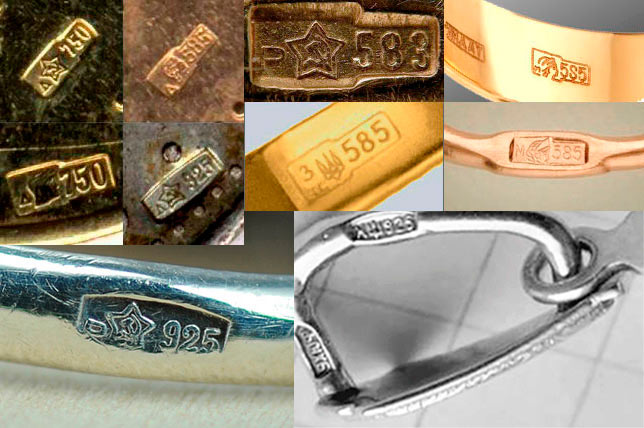Silver 925 and 585 gold, what is the difference between metals of different standards?
Probably many people don't know what is the difference between products made of the same noble metals but having different samples. To understand you must first understand what is a standard (fineness). The fineness is a number indicating the amount of grams the pure precious metal in 1 kg of the total alloy. There are many samples used in the world. The difference can be in the country of the manufacturer of the product, expressed in the emblem of the coat of arms also in the numerical value of the fineness. There are some people have products with samples of the standards of the Soviet Union in the post-Soviet countries.
The white gold 585 may not have the color of the alloy but rhodium plating which covers many works of jewelry. There is also the so-called pure red gold - it has a very high sample, close to 999 it is should not be confused with red gold. It turns out when high sample of gold is heated it a little oxidizes and a reddish tint appears. Unlike pure red gold the red is dimmer.
Also, due to the different proportions of different metals in the ligature, the final product (alloy of 585 gold) can be pink or even black.
Ligature
All metal wich is not basic in the alloy is called a ligature. Accordingly, the standard directly depends on the amount of ligature. The ligature may or may not contain precious metals in the general alloy. For example, 1 kg of 585 gold alloy may contain 300 grams of silver, or maybe simple copper. Everything depends from the desired properties in particular the color of the future 585 gold.925 sterling silver
For example, the most common sample of silver is 925 (it is also called sterling silver with most jewelry is made). This means: 1 kg of a product of chemically pure silver having 925 grams, and the remaining 75 grams contain another metal, as a rule, copper with additions of zinc and cadmium.585 gold standard (different colors of gold)
The common fineness of gold is 585, respectively in 1 kg of this alloy contain 585 grams of pure gold and 415 grams of other metals (ligatures), usually copper, silver, and other components (for example, platinum, palladium or nickel). This is the secret of 585 red and white gold. Pure gold has a bright yellow color and copper is the only red metal in the world wich adds redness to a gold piece. The silver, platinum, palladium and nickel is change the product towards white.The white gold 585 may not have the color of the alloy but rhodium plating which covers many works of jewelry. There is also the so-called pure red gold - it has a very high sample, close to 999 it is should not be confused with red gold. It turns out when high sample of gold is heated it a little oxidizes and a reddish tint appears. Unlike pure red gold the red is dimmer.
Also, due to the different proportions of different metals in the ligature, the final product (alloy of 585 gold) can be pink or even black.
Why using the alloys?
There are the next question: why use alloys because it is better to make jewelry out "purity"? Answer: for changing the properties of the product. Consider silver and gold as an example. These metals are very soft and a chain of pure silver or gold is very easy to spoil or deform. This products are not suitable for using. The copper adds rigidity to them which makes the products more wear-resistant. Another important factor in the use of alloys is opportunity to makes produce jewelry of absolutely the same shape, color, and similar in weight but at completely different prices.Published: 09.01.2018
Rating:







